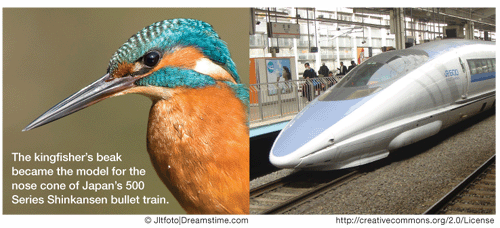Quieter Than a Speeding Bullet
God’s creation has inspired many of man’s greatest designs.
Japan operates some of the world’s fastest electric trains, which travel in excess of 200 miles per hour (322 km/h). The trains have an excellent safety record, but one problem has nagged engineers for years. Japan’s rail system has many tunnels. When a train passes through such a tunnel at high speed, it compresses the air in front of the engine. Upon leaving the tunnel, this air rushes outward, creating a loud thunderclap, or sonic boom. Nearby windows rattle, and people are awakened by the noise. Japan has strict laws on sound pollution, and design engineers sought a solution to the “tunnel boom” problem. They found the surprising answer in nature.
The kingfisher is a comical bird with a large head, extra-long beak, and stubby tail. Despite its ungainly appearance, this bird is an excellent fisherman. From its perch on a branch, it will dive straight down into water at high speed, with very little splash. It’s the envy of Olympic divers.
What interested engineers? Wind tunnel experiments verify that the kingfisher’s bill is ideally shaped for a smooth, streamlined transition from air into water. This drastic change in pressure is similar to the change a bullet train experiences when emerging from a tunnel into the open air.
As a result of such studies, the front ends of many Japanese bullet trains have been redesigned to mimic the shape of the kingfisher’s bill.1
New train engines have long, tapered, futuristic noses. As a result, sound is greatly diminished when they exit tunnels, and overall train vibration is lessened.
As an added bonus, the streamlined design reduces total energy consumption by 15 percent. Even the recessed headlights of the train engines are modeled after the nostrils of the kingfisher.
The aerodynamic kingfisher has led the way in achieving smooth, quiet train operation. As biomimicry expert Janine Benyus concludes, “We are surrounded by genius.”2

Nature appears to be programmed with endless useful ideas that await our discovery and application. The standard evolutionary explanation is that the designs we see around us are only apparent and ultimately the product of chance accidents. In this view, the shape of the kingfisher has been fine-tuned by countless generations of trial and error, and luck.
Contrary to the expectations of the evolutionary model, the fossil record does not show evidence of the assumed stages of poor design and misfits. Instead, all creatures, living and in the past, appear exquisitely designed.
As Job 12:7–9 advises us, “Ask the beasts, and they will teach you; and the birds of the air, and they will tell you . . . that the hand of the Lord has done this.”
Answers Magazine
July – September 2009
How do I deal with cancer? Why did God allow evil in the world? Why do snakes appear designed to kill? God’s curse is a historical reality, and we can see its results in everyday life. Don’t miss this special issue, which will give you the tools to tackle questions about evil and its true origin.
Browse IssueFootnotes
- K. Kobayashi, Japan for Sustainability Newsletter #31, March 2005.
- S. Fornoff, “Nature May Offer Vital Clues on Rebuilding New Orleans,” San Francisco Chronicle online, September 14, 2005.
Recommended Resources

Answers in Genesis is an apologetics ministry, dedicated to helping Christians defend their faith and proclaim the good news of Jesus Christ.
- Customer Service 800.778.3390
- Available Monday–Friday | 9 AM–5 PM ET
- © 2026 Answers in Genesis




